Critical Review & Report: Nursing Leadership & Indigenous Policies
VerifiedAdded on 2023/03/31
|6
|927
|439
Report
AI Summary
This report provides a critical review of nursing leadership in contemporary healthcare, with a specific focus on policies aimed at improving Indigenous health outcomes. It emphasizes the importance of integrating the REM (Respect, Engagement, Moving forward) framework to enhance cultural competence among healthcare professionals. The report assesses various strategies, including workforce action plans and policy directives, aimed at addressing health disparities between Aboriginal and non-Aboriginal populations. Recommendations are made to strengthen clinical practices, promote Aboriginal workforce participation, and ensure culturally safe healthcare environments. The analysis underscores the need for ongoing discussion, ethical nursing practices, and the application of Indigenous research methodologies to foster successful outcomes and employee engagement within healthcare entities.
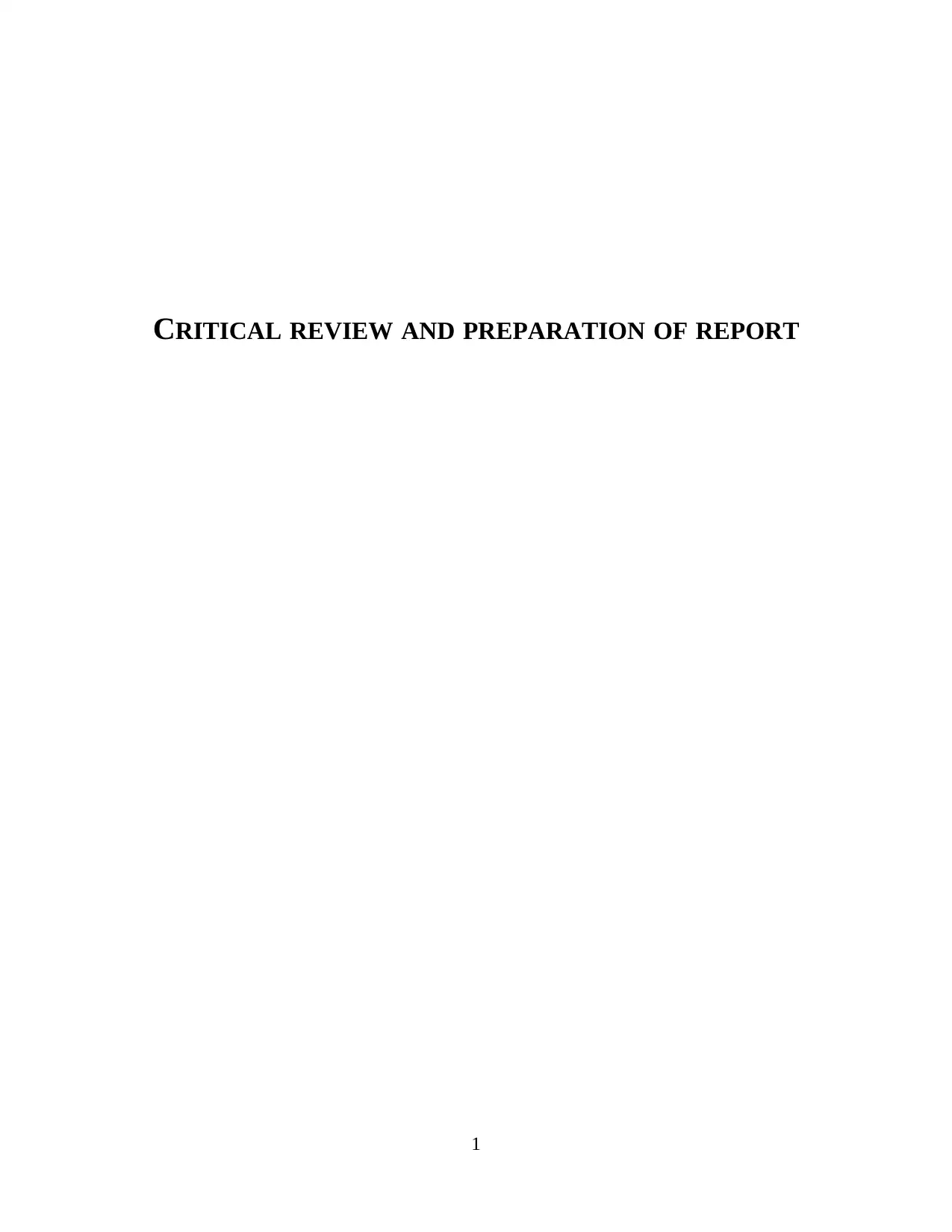
CRITICAL REVIEW AND PREPARATION OF REPORT
1
1
Paraphrase This Document
Need a fresh take? Get an instant paraphrase of this document with our AI Paraphraser
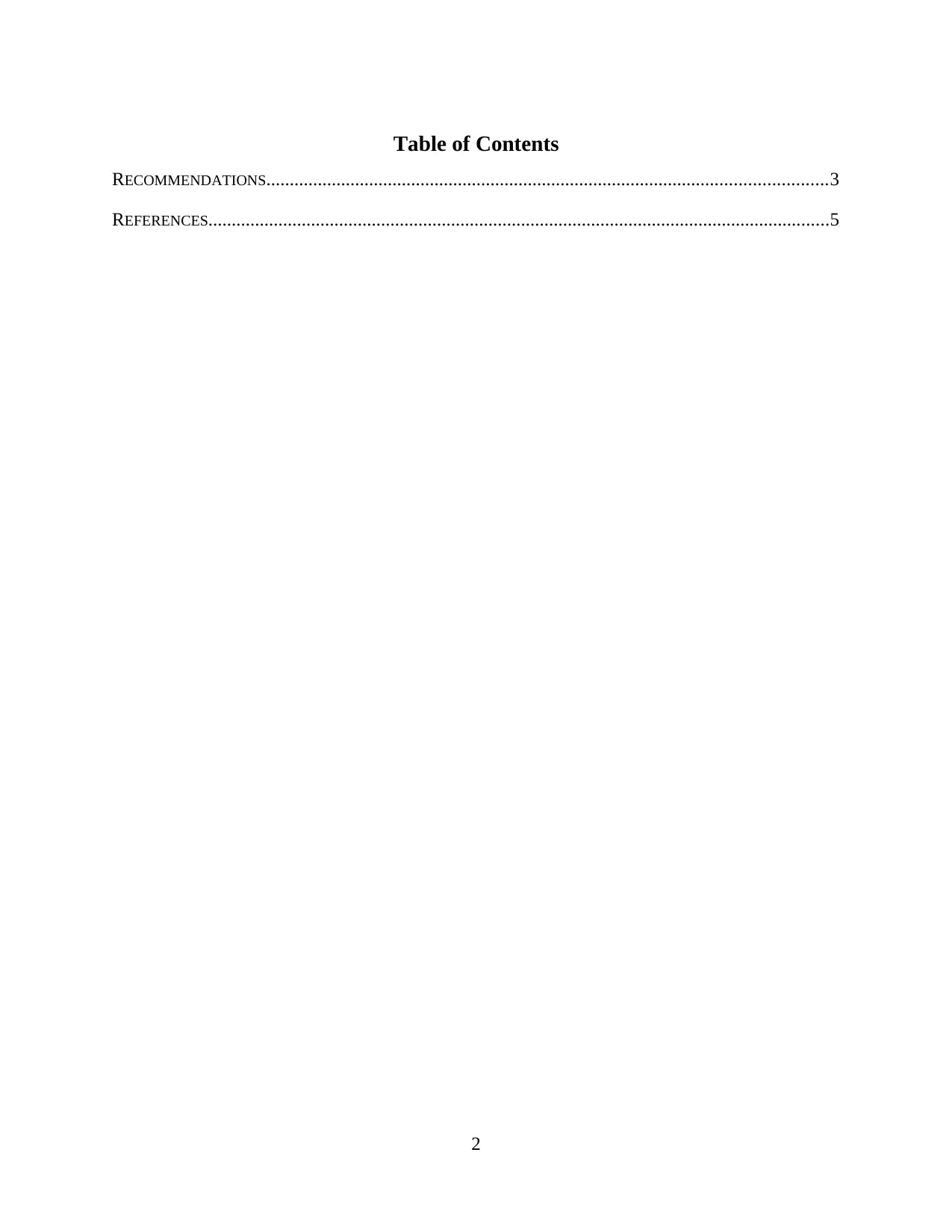
Table of Contents
RECOMMENDATIONS........................................................................................................................3
REFERENCES.....................................................................................................................................5
2
RECOMMENDATIONS........................................................................................................................3
REFERENCES.....................................................................................................................................5
2
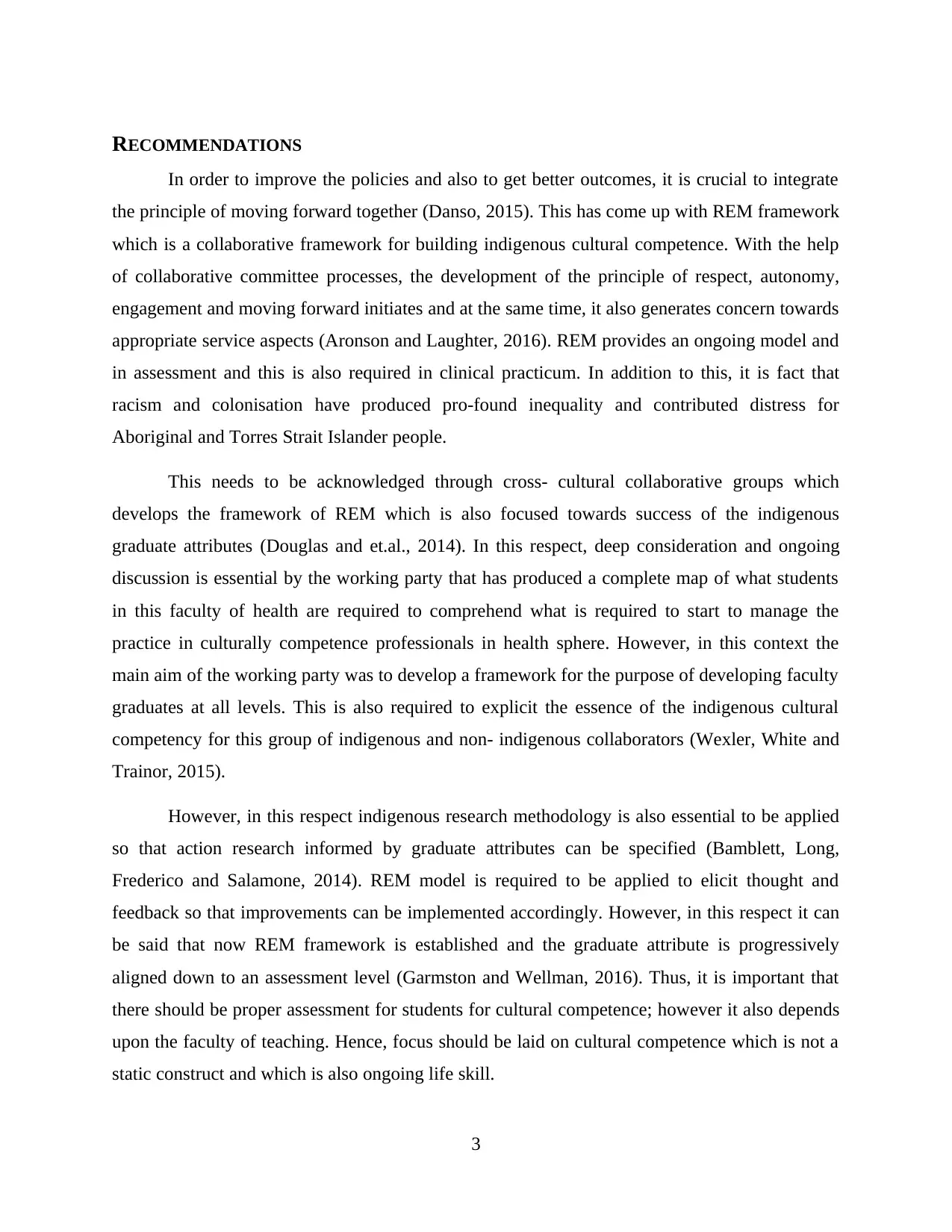
RECOMMENDATIONS
In order to improve the policies and also to get better outcomes, it is crucial to integrate
the principle of moving forward together (Danso, 2015). This has come up with REM framework
which is a collaborative framework for building indigenous cultural competence. With the help
of collaborative committee processes, the development of the principle of respect, autonomy,
engagement and moving forward initiates and at the same time, it also generates concern towards
appropriate service aspects (Aronson and Laughter, 2016). REM provides an ongoing model and
in assessment and this is also required in clinical practicum. In addition to this, it is fact that
racism and colonisation have produced pro-found inequality and contributed distress for
Aboriginal and Torres Strait Islander people.
This needs to be acknowledged through cross- cultural collaborative groups which
develops the framework of REM which is also focused towards success of the indigenous
graduate attributes (Douglas and et.al., 2014). In this respect, deep consideration and ongoing
discussion is essential by the working party that has produced a complete map of what students
in this faculty of health are required to comprehend what is required to start to manage the
practice in culturally competence professionals in health sphere. However, in this context the
main aim of the working party was to develop a framework for the purpose of developing faculty
graduates at all levels. This is also required to explicit the essence of the indigenous cultural
competency for this group of indigenous and non- indigenous collaborators (Wexler, White and
Trainor, 2015).
However, in this respect indigenous research methodology is also essential to be applied
so that action research informed by graduate attributes can be specified (Bamblett, Long,
Frederico and Salamone, 2014). REM model is required to be applied to elicit thought and
feedback so that improvements can be implemented accordingly. However, in this respect it can
be said that now REM framework is established and the graduate attribute is progressively
aligned down to an assessment level (Garmston and Wellman, 2016). Thus, it is important that
there should be proper assessment for students for cultural competence; however it also depends
upon the faculty of teaching. Hence, focus should be laid on cultural competence which is not a
static construct and which is also ongoing life skill.
3
In order to improve the policies and also to get better outcomes, it is crucial to integrate
the principle of moving forward together (Danso, 2015). This has come up with REM framework
which is a collaborative framework for building indigenous cultural competence. With the help
of collaborative committee processes, the development of the principle of respect, autonomy,
engagement and moving forward initiates and at the same time, it also generates concern towards
appropriate service aspects (Aronson and Laughter, 2016). REM provides an ongoing model and
in assessment and this is also required in clinical practicum. In addition to this, it is fact that
racism and colonisation have produced pro-found inequality and contributed distress for
Aboriginal and Torres Strait Islander people.
This needs to be acknowledged through cross- cultural collaborative groups which
develops the framework of REM which is also focused towards success of the indigenous
graduate attributes (Douglas and et.al., 2014). In this respect, deep consideration and ongoing
discussion is essential by the working party that has produced a complete map of what students
in this faculty of health are required to comprehend what is required to start to manage the
practice in culturally competence professionals in health sphere. However, in this context the
main aim of the working party was to develop a framework for the purpose of developing faculty
graduates at all levels. This is also required to explicit the essence of the indigenous cultural
competency for this group of indigenous and non- indigenous collaborators (Wexler, White and
Trainor, 2015).
However, in this respect indigenous research methodology is also essential to be applied
so that action research informed by graduate attributes can be specified (Bamblett, Long,
Frederico and Salamone, 2014). REM model is required to be applied to elicit thought and
feedback so that improvements can be implemented accordingly. However, in this respect it can
be said that now REM framework is established and the graduate attribute is progressively
aligned down to an assessment level (Garmston and Wellman, 2016). Thus, it is important that
there should be proper assessment for students for cultural competence; however it also depends
upon the faculty of teaching. Hence, focus should be laid on cultural competence which is not a
static construct and which is also ongoing life skill.
3
⊘ This is a preview!⊘
Do you want full access?
Subscribe today to unlock all pages.

Trusted by 1+ million students worldwide
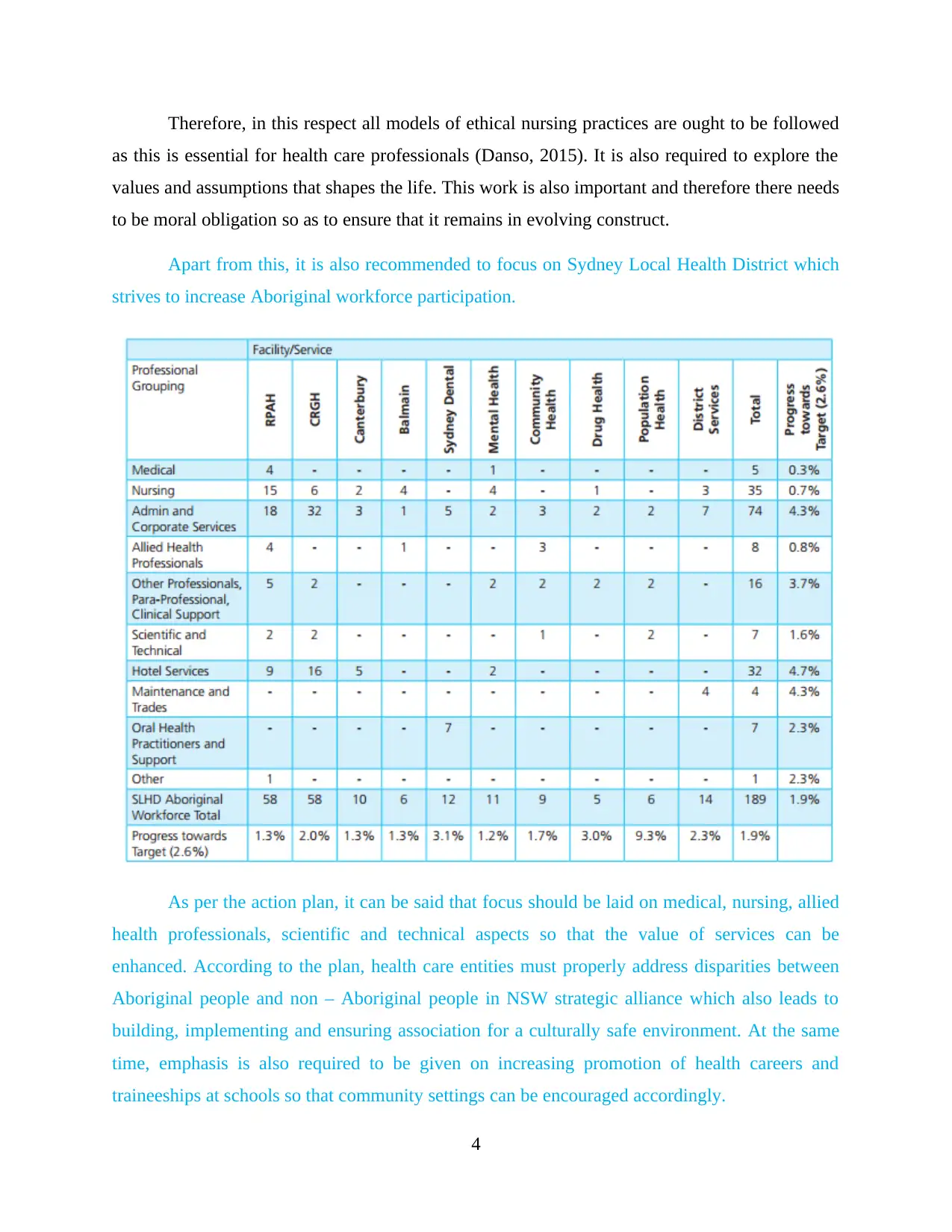
Therefore, in this respect all models of ethical nursing practices are ought to be followed
as this is essential for health care professionals (Danso, 2015). It is also required to explore the
values and assumptions that shapes the life. This work is also important and therefore there needs
to be moral obligation so as to ensure that it remains in evolving construct.
Apart from this, it is also recommended to focus on Sydney Local Health District which
strives to increase Aboriginal workforce participation.
As per the action plan, it can be said that focus should be laid on medical, nursing, allied
health professionals, scientific and technical aspects so that the value of services can be
enhanced. According to the plan, health care entities must properly address disparities between
Aboriginal people and non – Aboriginal people in NSW strategic alliance which also leads to
building, implementing and ensuring association for a culturally safe environment. At the same
time, emphasis is also required to be given on increasing promotion of health careers and
traineeships at schools so that community settings can be encouraged accordingly.
4
as this is essential for health care professionals (Danso, 2015). It is also required to explore the
values and assumptions that shapes the life. This work is also important and therefore there needs
to be moral obligation so as to ensure that it remains in evolving construct.
Apart from this, it is also recommended to focus on Sydney Local Health District which
strives to increase Aboriginal workforce participation.
As per the action plan, it can be said that focus should be laid on medical, nursing, allied
health professionals, scientific and technical aspects so that the value of services can be
enhanced. According to the plan, health care entities must properly address disparities between
Aboriginal people and non – Aboriginal people in NSW strategic alliance which also leads to
building, implementing and ensuring association for a culturally safe environment. At the same
time, emphasis is also required to be given on increasing promotion of health careers and
traineeships at schools so that community settings can be encouraged accordingly.
4
Paraphrase This Document
Need a fresh take? Get an instant paraphrase of this document with our AI Paraphraser
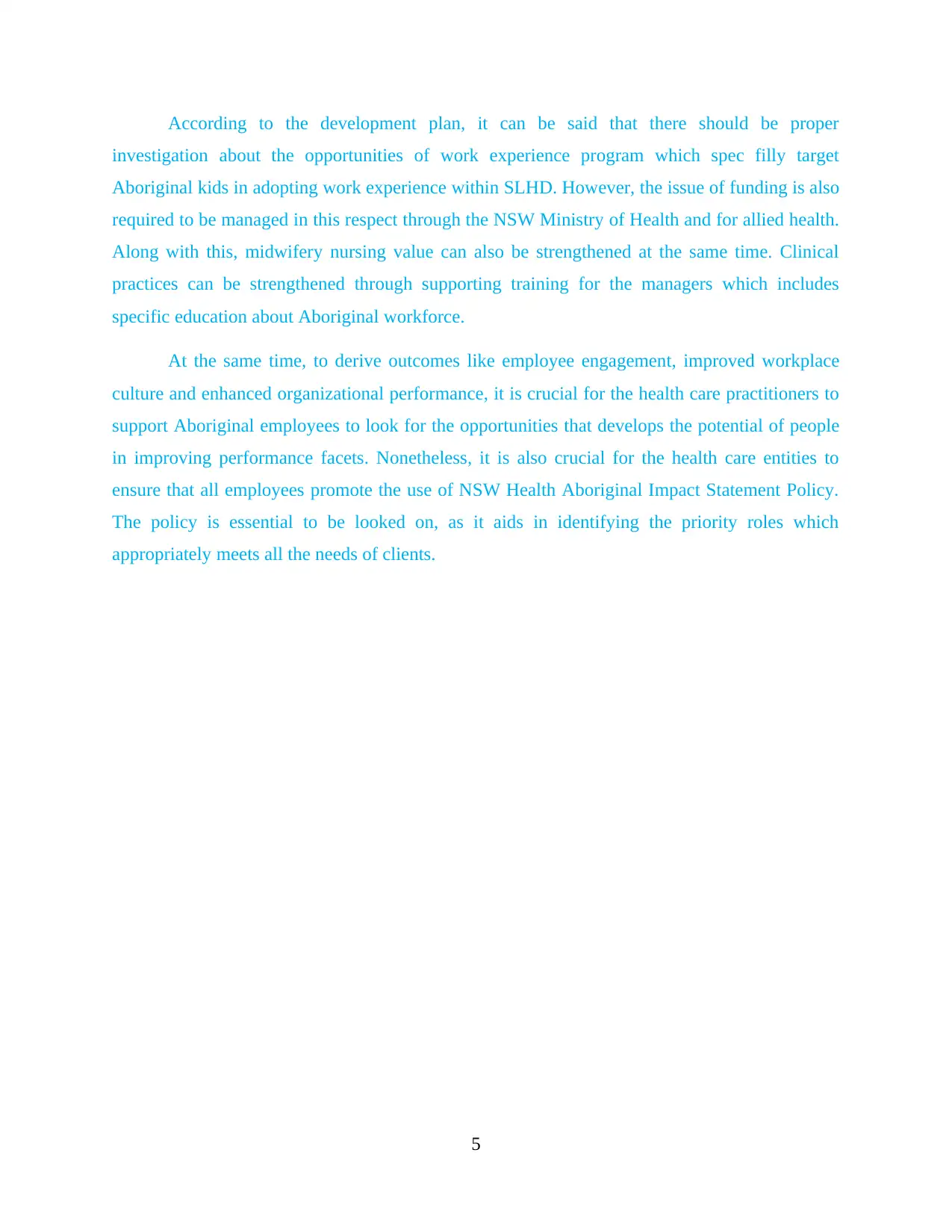
According to the development plan, it can be said that there should be proper
investigation about the opportunities of work experience program which spec filly target
Aboriginal kids in adopting work experience within SLHD. However, the issue of funding is also
required to be managed in this respect through the NSW Ministry of Health and for allied health.
Along with this, midwifery nursing value can also be strengthened at the same time. Clinical
practices can be strengthened through supporting training for the managers which includes
specific education about Aboriginal workforce.
At the same time, to derive outcomes like employee engagement, improved workplace
culture and enhanced organizational performance, it is crucial for the health care practitioners to
support Aboriginal employees to look for the opportunities that develops the potential of people
in improving performance facets. Nonetheless, it is also crucial for the health care entities to
ensure that all employees promote the use of NSW Health Aboriginal Impact Statement Policy.
The policy is essential to be looked on, as it aids in identifying the priority roles which
appropriately meets all the needs of clients.
5
investigation about the opportunities of work experience program which spec filly target
Aboriginal kids in adopting work experience within SLHD. However, the issue of funding is also
required to be managed in this respect through the NSW Ministry of Health and for allied health.
Along with this, midwifery nursing value can also be strengthened at the same time. Clinical
practices can be strengthened through supporting training for the managers which includes
specific education about Aboriginal workforce.
At the same time, to derive outcomes like employee engagement, improved workplace
culture and enhanced organizational performance, it is crucial for the health care practitioners to
support Aboriginal employees to look for the opportunities that develops the potential of people
in improving performance facets. Nonetheless, it is also crucial for the health care entities to
ensure that all employees promote the use of NSW Health Aboriginal Impact Statement Policy.
The policy is essential to be looked on, as it aids in identifying the priority roles which
appropriately meets all the needs of clients.
5
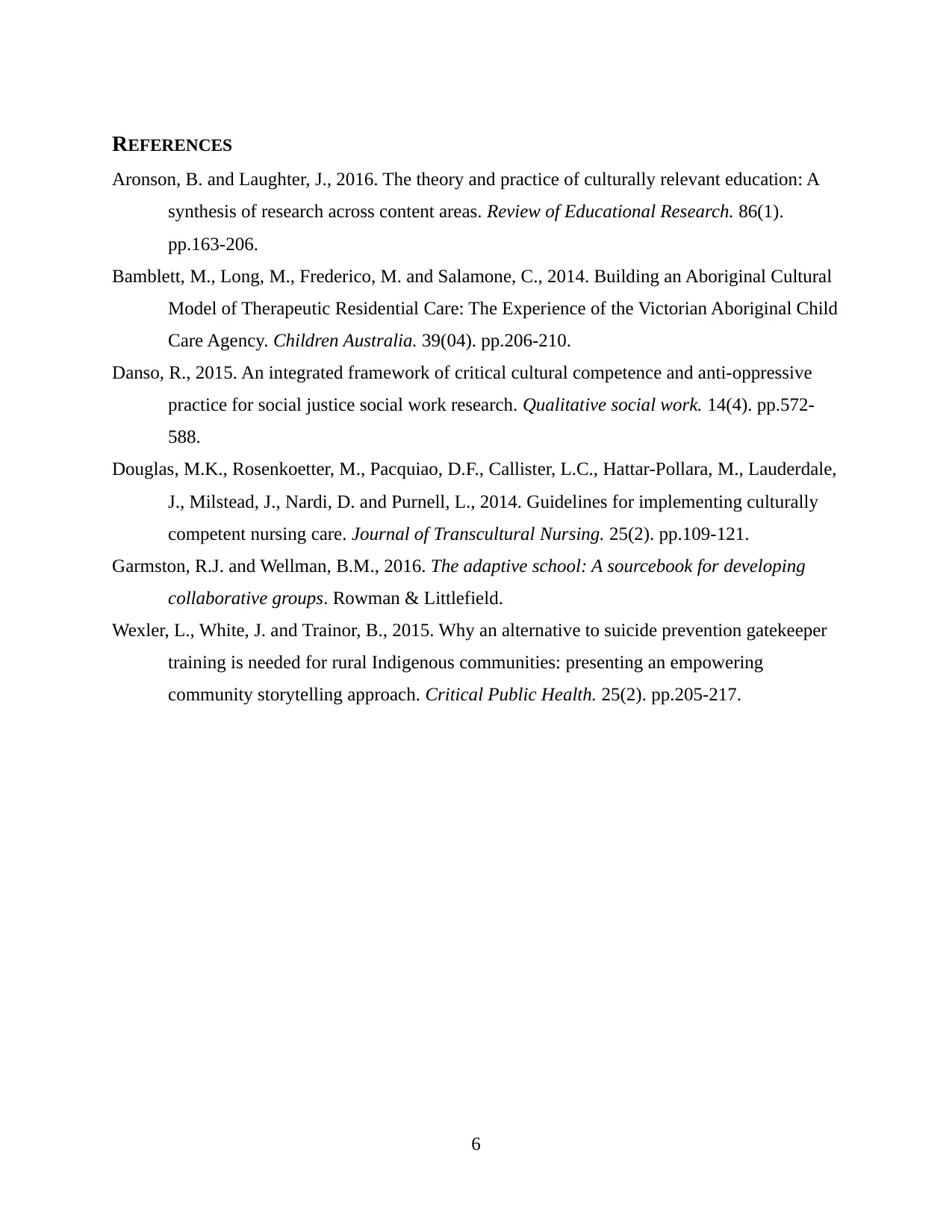
REFERENCES
Aronson, B. and Laughter, J., 2016. The theory and practice of culturally relevant education: A
synthesis of research across content areas. Review of Educational Research. 86(1).
pp.163-206.
Bamblett, M., Long, M., Frederico, M. and Salamone, C., 2014. Building an Aboriginal Cultural
Model of Therapeutic Residential Care: The Experience of the Victorian Aboriginal Child
Care Agency. Children Australia. 39(04). pp.206-210.
Danso, R., 2015. An integrated framework of critical cultural competence and anti-oppressive
practice for social justice social work research. Qualitative social work. 14(4). pp.572-
588.
Douglas, M.K., Rosenkoetter, M., Pacquiao, D.F., Callister, L.C., Hattar-Pollara, M., Lauderdale,
J., Milstead, J., Nardi, D. and Purnell, L., 2014. Guidelines for implementing culturally
competent nursing care. Journal of Transcultural Nursing. 25(2). pp.109-121.
Garmston, R.J. and Wellman, B.M., 2016. The adaptive school: A sourcebook for developing
collaborative groups. Rowman & Littlefield.
Wexler, L., White, J. and Trainor, B., 2015. Why an alternative to suicide prevention gatekeeper
training is needed for rural Indigenous communities: presenting an empowering
community storytelling approach. Critical Public Health. 25(2). pp.205-217.
6
Aronson, B. and Laughter, J., 2016. The theory and practice of culturally relevant education: A
synthesis of research across content areas. Review of Educational Research. 86(1).
pp.163-206.
Bamblett, M., Long, M., Frederico, M. and Salamone, C., 2014. Building an Aboriginal Cultural
Model of Therapeutic Residential Care: The Experience of the Victorian Aboriginal Child
Care Agency. Children Australia. 39(04). pp.206-210.
Danso, R., 2015. An integrated framework of critical cultural competence and anti-oppressive
practice for social justice social work research. Qualitative social work. 14(4). pp.572-
588.
Douglas, M.K., Rosenkoetter, M., Pacquiao, D.F., Callister, L.C., Hattar-Pollara, M., Lauderdale,
J., Milstead, J., Nardi, D. and Purnell, L., 2014. Guidelines for implementing culturally
competent nursing care. Journal of Transcultural Nursing. 25(2). pp.109-121.
Garmston, R.J. and Wellman, B.M., 2016. The adaptive school: A sourcebook for developing
collaborative groups. Rowman & Littlefield.
Wexler, L., White, J. and Trainor, B., 2015. Why an alternative to suicide prevention gatekeeper
training is needed for rural Indigenous communities: presenting an empowering
community storytelling approach. Critical Public Health. 25(2). pp.205-217.
6
⊘ This is a preview!⊘
Do you want full access?
Subscribe today to unlock all pages.

Trusted by 1+ million students worldwide
1 out of 6
Related Documents
Your All-in-One AI-Powered Toolkit for Academic Success.
+13062052269
info@desklib.com
Available 24*7 on WhatsApp / Email
![[object Object]](/_next/static/media/star-bottom.7253800d.svg)
Unlock your academic potential
Copyright © 2020–2025 A2Z Services. All Rights Reserved. Developed and managed by ZUCOL.





